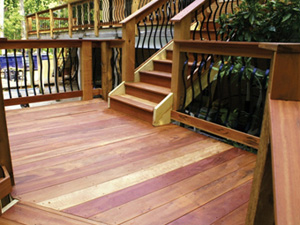This little stair jack used to bug me a great deal, but it’s really grown on me over time.
Common trade names: Zebrawood, Tigerwood, Brazilian Tigerwood, Goncalo Alves
Genus: Astronium fraxinifolium, Astronium graveolens
Janka Hardness (pounds-force): 2250
Description: Known for its distinctively bold grain patterns and varied coloring, Goncalo Alves (American Tigerwood) features a moderate reddish/brown coloring highlighted by deep brown and black streaks in the grain pattern. Its strength lies somewhere in the neighborhood of Jatoba, and for comparative purposes, the strengths of North American Maple and Red Oak are 1450 and 1290 respecively. Tigerwood is still a very strong material. Takes finish and works relatively well, considering it’s stiffness.
Location: Mexico through South America
Common Aliases: Brazilian tigerwood, Jobillo (among turners preferring higher grades of Goncalo Alves)
Performance: It’s quite moisture-resistent, it’s hard to glue, it’s hard (easy in comparison to Ipe or Cumaru) to cut. Again, don’t take an air gun to this wood. I’ve mentioned this occasionally with other species, but as long as I’m fielding phone calls about this topic, please don’t attempt to use compressed tools with this species if someone else is in the room. If you’re looking to make a statement on a design project, Brazilian Tigerwood is hard to beat. It’s priced a little more moderately than our top sellers, and will yield many effective years of life. weather or pest. Do not use compressed air tools without wearing goggles, gloves, thick clothing, in an otherwise empty room, as the fasteners will be airborne and elsewhere once you attempt to nail this material. Pre-drill, then screw, and it holds remarkably well. Hidden fastening systems are a great alternative to face fastening for a cleaner presentation.
Acclimation: Please, always properly store and set aside your lumber! We can’t stress enough the importance of just a little patience when receiving your order. For air drying, simply allow a half-inch or so among parallel planks stacked and spaced by level. It’s that easy, and in two or so weeks’ time, the lumber is ready for installation in your climate!
Common Uses: I’ve seen some rain screen siding in Tigerwood that made a sharp architectural statement. We’ve sold Tigerwood predominantly for decks and shiplap cladding applications to this point, but its uses as a furniture lumber are more than adequate for the experienced woodworker. Once again, remember to purchase your wood kiln dried for interior applications only, if at all possible. For interior kiln dried lumber, uses include flooring, cabinetry, turnings, and Goncalo Alves can make for striking imagery in the finished product.
From: The Wood Database
Goncalo Alves (Astronium graveolens)
Common Name(s): Goncalo Alves, Tigerwood, Jobillo
Scientific Name: Astronium graveolens (syn. A. fraxinifolium)
Distribution: From Mexico southward to Brazil
Tree Size: 100-130 ft (30-40 m) tall, 3-5 ft (1-1.5 m) trunk diameter
Average Dried Weight: 62 lbs/ft3 (995 kg/m3)
Basic Specific Gravity: .80
Hardness: 2,250 lbf (10,000 N)
Rupture Strength: 18,400 lbf/in2 (126,920 kPa)
Elastic Strength: 2,404,000 lbf/in2 (16,580 MPa)
Crushing Strength: 10,710 lbf/in2 (73.9 MPa)
Shrinkage: Radial: 4.0%, Tangential: 7.6%, Volumetric: 10.0%, T/R Ratio: 1.9
